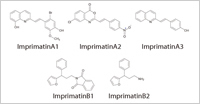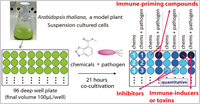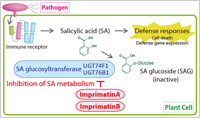Enlarge Image Figure caption: Molecular structures of the isolated Imprimatins.
Enlarge Image Figure caption: The established original screening method for immune response regulators.
Enlarge Image Figure caption: Action point of Imprimatins in immunity signaling in plants.
Enlarge Image
Identification of new plant activator compounds for sustainable agriculture
Plant activators are chemical compounds that protect crops from diseases in the field by activating the plant's immune system. Unlike pesticides, plant activators are not overcome by drug resistant pathogens, and thus provide durability. Plant activator technology was developed in Japan and is widely used in wet-rice cultivation in East Asia. However, the molecular mechanisms of plant activators remain unclear.
Despite their advantages, the applications of plant activators are still limited due to the lack of appropriate high-throughput screening procedures. Also one of the key problems is that the constitutive activation of immune responses is often associated with arrested growth and reductions in crop yield.
Now, Yoshiteru Noutoshi and colleagues at Okayama University and RIKEN Plant Science Center have established a new screening technique that can distinguish between compounds that induce immune responses on their own, from those that do so exclusively in the presence of a pathogen.
Five compounds—named Imprimatin—were successfully identified from a total of 10,000 compounds and they increased disease resistance in Arabidopsis plants against pathogenic Pseudomonas bacterial by priming immune response without direct induction of defense genes.
Further investigations revealed that these Imprimatins inhibit two enzymes that inactivate the plant immune hormone salicylic acid (SA glucosyl transferases or SAGTs), and this targeting was confirmed by gene knockout experiments, where plants without these enzymes mimicked the chemically-treated phenotypes and exhibited enhanced disease resistance.
Our results demonstrate the effectiveness of the new screening technique for finding useful plant activators and the power of SA metabolism as a strategy for crop protection.
Reference:
・ Authors: Yoshiteru Noutoshi, Masateru Okazaki, Tatsuya Kida, Yuta Nishina, Yoshihiko Morishita, Takumi Ogawa, Hideyuki Suzuki, Daisuke Shibata, Yusuke Jikumaru, Atsushi Hanada, Yuji Kamiya, and Ken Shirasu.
・ Title of original paper: Novel plant immune-priming compounds identified via high-throughput chemical screening target salicylic acid glucosyltransferases in Arabidopsis.
・ Journal, volume, pages and year: The Plant Cell 24(9), 3795-3804. (2012).
・ Digital Object Identifier (DOI): 10.1105/tpc.112.098343
・ Affiliations: Research Core for Interdisciplinary Sciences (RCIS), Okayama University, 3-1-1 Tsushima-naka, Kita-ku, Okayama, 700-8530 Japan
・ Author website: http://noutoshi-lab.com/english/index_e.html




